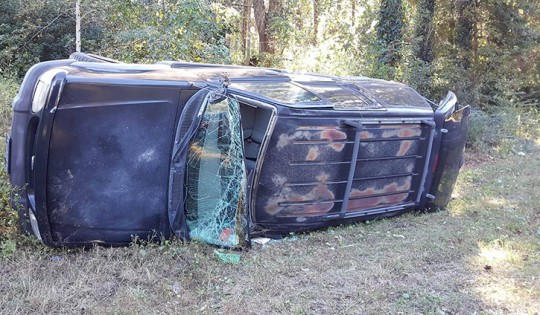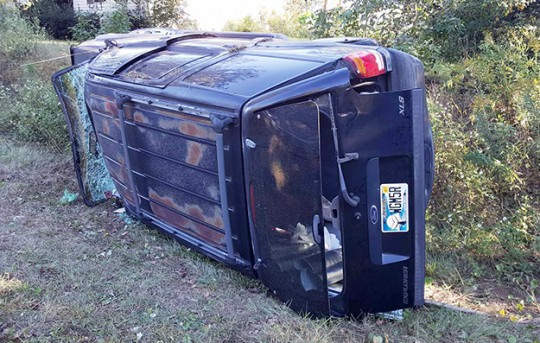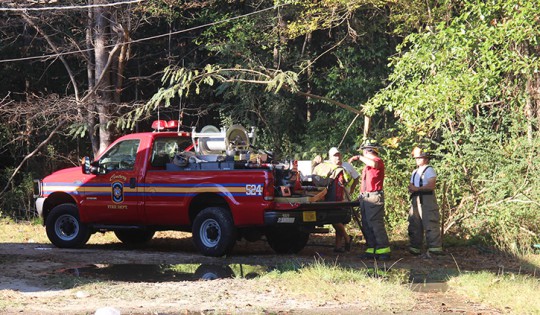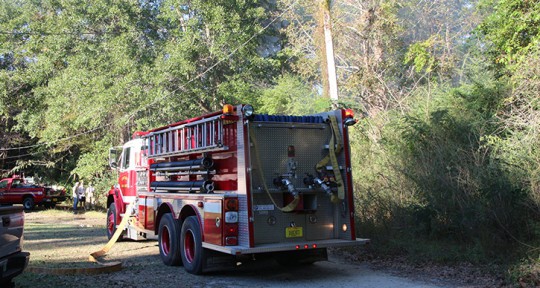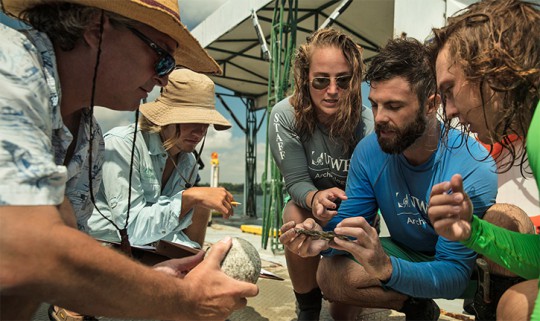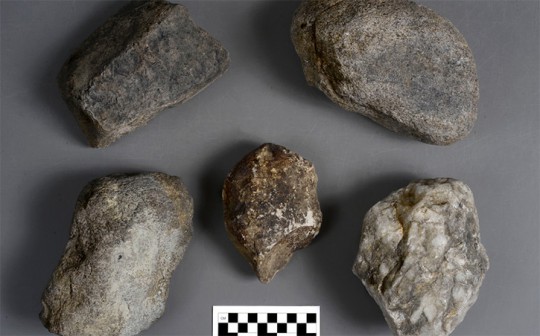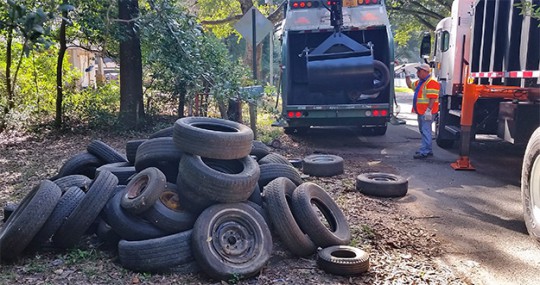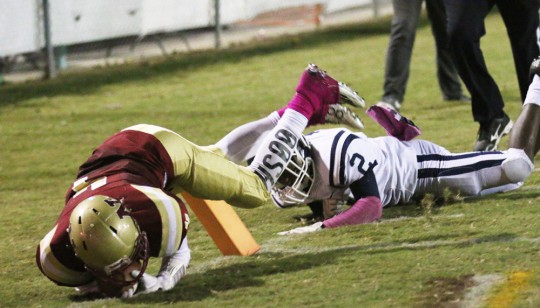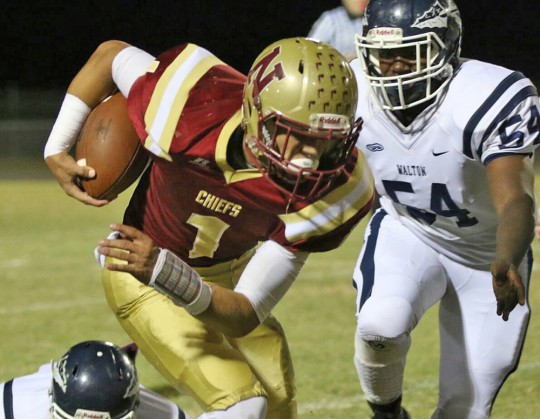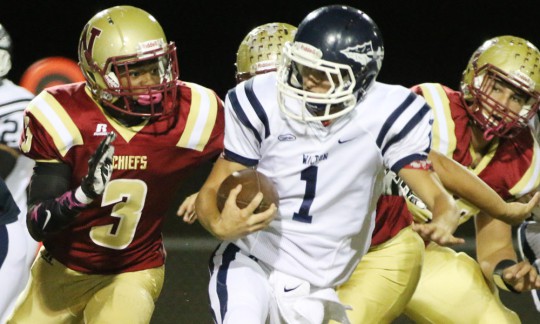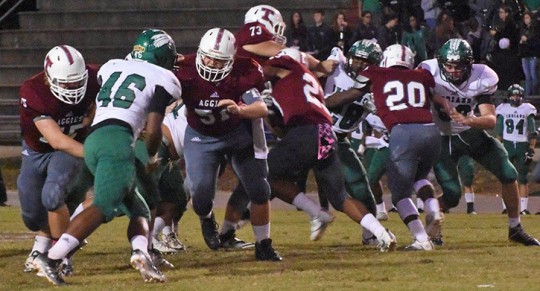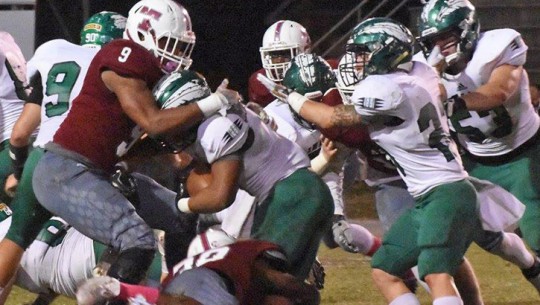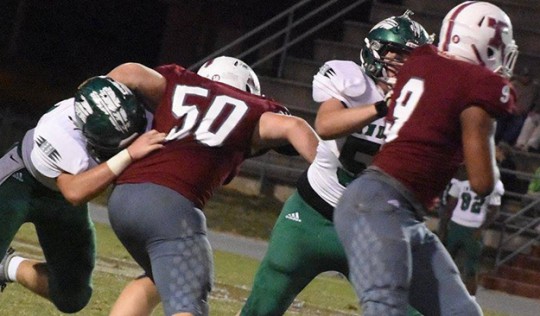Florida Gov’t Weekly Roundup: Beginning To Look Familiar
October 23, 2016
A major figure in the Clinton White House visited Florida this week as part of a bid for the presidency. The two political parties fought over election rules in court. And there was talk of a rigged election.
Welcome back to 2000.
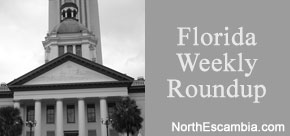 There are some significant differences between the storylines of the current day and those of 16 years ago. It’s now former First Lady (and, since then, U.S. Senator and Secretary of State) Hillary Clinton running for office, instead of then-Vice President Al Gore. The fights in court are about the rules before the votes are counted rather than after. And talk of a vast conspiracy to fix the results was mostly confined to the fringes back then; this year, Republican presidential nominee Donald Trump has taken up the mantle.
There are some significant differences between the storylines of the current day and those of 16 years ago. It’s now former First Lady (and, since then, U.S. Senator and Secretary of State) Hillary Clinton running for office, instead of then-Vice President Al Gore. The fights in court are about the rules before the votes are counted rather than after. And talk of a vast conspiracy to fix the results was mostly confined to the fringes back then; this year, Republican presidential nominee Donald Trump has taken up the mantle.
Still, it was hard to look at it all and not consider the idea often attributed to Mark Twain that while history doesn’t repeat itself, it does rhyme.
Floridians hope that rhyming is all there is. The last thing anyone wants is for 2000 to repeat itself for real.
SIX YEARS — BARRING DIVINE INTERVENTION
The U.S. Senate race between incumbent Republican Marco Rubio and Democratic Congressman Patrick Murphy has remained largely in the shadows this year as Clinton and Trump have fought over Florida’s 29 electoral votes. But the race began to emerge this week with the first of what now looks to be two debates between Rubio and Murphy.
The headline of the debate was Rubio coming as close as he has to committing to serve the entirety of a second term in the Senate — unless a higher authority weighs in.
“I’m going to serve in the Senate for the next six years, God willing,” Rubio said.
It was pushback against one of Murphy’s most persistent charges against Rubio — that the Republican all but abandoned his seat to run for president in 2016 and might do so again in 2020 if Trump fails to capture the White House, as looks increasingly likely.
Rubio’s comment appeared to catch Murphy off guard. A few moments later, the Democrat rattled off that Rubio still hadn’t vowed to “commit to serving a full term,” as he responded to a question about his own business career.
“That’s a line he practiced before I said what I actually said today,” remarked Rubio.
There was a note of irony to the call-out, given that Rubio’s presidential campaign stumbled badly after he repeated a line almost verbatim four times at a debate, something that N.J. Gov. Chris Christie was quick to point out.
But 2016 politics is still 2016 politics, and Trump loomed over the debate. Murphy slammed Rubio for refusing to unendorse the Republican candidate despite offensive comments about women, immigrants and others.
“If you can’t stand up to Donald Trump as a candidate, how in the world are you going to stand up to him as the president of the United States?” Murphy asked. “This is about what he’s done. Think of how unqualified he is. Just a couple of weeks (ago) it came out that he’s violated the (Cuba) embargo, something that I know you care a lot about. And you still stand by his side.”
Rubio, repeated a line he rolled out prior to the debate, that neither presidential candidate is inspirational. And that while he disagrees with a lot of what Trump says and does, Rubio said he disagrees with everything from Clinton.
“I don’t trust either one of them, and the job of a U.S. senator is not to blindly follow the president because they happen to be from your own party,” Rubio said.
For the record, Rubio rejected Trump’s assertions that the presidential election could be rigged. Whether his attempts to distance himself from the nominee are working is questionable after a new poll this week showed the Senate race is essentially a dead heat.
Rubio led by two points, 49 percent to 47 percent, in a Quinnipiac University poll conducted before the debate. That’s well within the poll’s margin of error.
DO YOU KNOW ‘JIU-JITSU’?
Groups that support solar power and oppose Amendment 1 on this year’s ballot have long argued that the utility-backed initiative is not exactly on the up-and-up. Now, an official with a Tallahassee-based think tank might have given them some evidence.
The Miami Herald first reported on an audio tape in which James Madison Institute Vice President of Policy Sal Nuzzo described how to use a “little bit of political jiu-jitsu” by promoting solar to win support for desired changes in policy. His comments came while speaking Oct. 2 at the “Energy/Environment Leadership Summit” in Nashville, Tenn.
“The point I would make, maybe the takeaway, is as you guys look at policy in your state or constitutional ballot initiatives in your state, remember this: Solar polls very well,” Nuzzo said on the tape, which has been posted online.
Amendment 1 foes jumped on a tape as evidence of utility-industry efforts to deceive voters.
“Amendment 1 is a con job and scam perpetuated on Florida voters,” said Stephen Smith, executive director of the Southern Alliance for Clean Energy, on a conference call following the tape’s release. “And we just have to get that word out.”
But the group Consumers for Smart Solar, which has led efforts to pass the proposed constitutional amendment on the Nov. 8 ballot, said the James Madison Institute wasn’t involved in planning or drafting the proposal.
Meanwhile, the James Madison Institute said Nuzzo misspoke about the conservative think tank having any role with Consumers for Smart Solar. The institute supports the initiative, which it says would provide consumer protection.
The Consumers for Smart Solar amendment would enshrine in the Florida Constitution existing rules regarding the use of solar energy by private property owners.
The proposal also includes a more contentious provision, which states that those who haven’t installed solar on their property “are not required to subsidize the costs of backup power and electric grid access to those who do.”
Proponents say the second provision provides consumer protections for people who don’t install solar panels. Opponents say it could result in “discriminatory charges” against rooftop solar users and limit the desire of people to go solar.
VOTING WRITES
While candidates and advocates were fighting for votes, U.S. District Judge Mark Walker was refereeing fights over how Floridians can cast ballots. The judge has been saddled with the task of wrangling order out of a pair of cases that could help decide the outcome of the Nov. 8 elections.
He opened the week by blasting a state law regarding vote-by-mail ballots as “indefensible” and arguing it threatened to disenfranchise voters.
The 30-page ruling focused on situations in which voters’ signatures submitted with mail-in ballots do not appear to match signatures on file with county supervisors of elections. Under a 2004 law, such mail-in ballots are rejected.
But siding with the Florida Democratic Party and the Democratic National Committee in a lawsuit filed against Secretary of State Ken Detzner, Walker issued a preliminary injunction ordering a process that would allow voters to resolve questions about such “mismatched signature ballots” — and have the ballots counted.
A key part of Walker’s ruling was that state law has allowed voters a process to fix — or, in legal parlance, “cure” — vote-by-mail ballots that do not include signatures. But it has not allowed a similar process for when signatures do not appear to match.
“It is illogical, irrational, and patently bizarre for the state of Florida to withhold the opportunity to cure from mismatched-signature voters while providing that same opportunity to no-signature voters,” Walker wrote. “And in doing so, the state of Florida has categorically disenfranchised thousands of voters arguably for no reason other than they have poor handwriting or their handwriting has changed over time.”
Walker, meanwhile, rejected Democrats’ efforts to draw him back into a case on voter registration after the judge ordered a one-week extension in the deadline for Floridians to sign up to cast ballots.
Siding with Detzner, Walker turned aside a request that he order elections officials to do more in processing tens of thousands of forms that poured in after the judge gave voters more time to register following Hurricane Matthew.
Democrats wanted Walker to call for more forceful action to make sure that all new, legal voter registration forms were verified by Sunday, the day before early voting starts in 50 of Florida’s 67 counties. They also wanted Detzner to be required to issue updated lists of registered voters as the process continues and for the judge “to clarify” that voters whose forms were still being verified could cast regular ballots, instead of provisional ones.
But Detzner and local elections officials argued that it would be difficult to process the registrations any faster and dismissed as implausible other ideas like having poll workers call to check on the status of pending registration forms.
“We can’t work people any harder, and we don’t have any more people,” said Bob Pass, an attorney for Detzner.
STORY OF THE WEEK: The U.S. Senate race between Sen. Marco Rubio and Congressman Patrick Murphy started shaping up as the two traded fire at a debate, and polls in the contest appeared to tighten.
QUOTE OF THE WEEK: “We have 67 counties in this state, each of which conduct their own elections. I promise you there is not a 67-county conspiracy to rig this election.”—U.S. Sen. Marco Rubio, trying to tamp down talk of fixed elections, during a Senate debate Monday.
by Brandon Larrabee, The News Service of Florida
Driver Escapes Injury In Morning Crash
October 22, 2016
The driver of Ford Explorer escaped injury in a single vehicle rollover accident Saturday morning on Highway 95A north of Barrineau Park Road.
The female driver, lost control, ran off the roadway and over turned. She refused medical treatment at the scene.
The accident is under investigation by the Florida Highway Patrol.
NorthEscambia.com photos by Kristi Barbour, click to enlarge.
Scott: Pensacola Area Adds 3,000 Jobs During Past Year
October 22, 2016
Governor Rick Scott announced that the Pensacola area added 3,300 new private-sector jobs over the last year as of September. The area’s unemployment rate was 4.9 percent, declining by 0.1 percentage point in the last year. Florida businesses created 17,900 private-sector jobs across the state during September 2016.
 Governor Scott said, “The Pensacola area added more than 3,000 new jobs over the year, which means thousands more Floridians now have the opportunities they need to succeed in Northwest Florida. These new jobs are incredibly important to helping Floridians provide for their families, which is why we will continue to cut taxes, diversify the economy, and make Florida more competitive for major jobs wins.”
Governor Scott said, “The Pensacola area added more than 3,000 new jobs over the year, which means thousands more Floridians now have the opportunities they need to succeed in Northwest Florida. These new jobs are incredibly important to helping Floridians provide for their families, which is why we will continue to cut taxes, diversify the economy, and make Florida more competitive for major jobs wins.”
The industry with the most job growth in the Pensacola area over the year was professional and business services with 900 new jobs. The Pensacola area had 4,600 job openings in September, which included 1,230 openings for high-skill, high-wage STEM occupations.
Florida’s statewide unemployment rate remained at 4.7 percent, the lowest rate since November 2007. For the 54th consecutive month, Florida’s annual job growth rate of 3.6 percent is also exceeding the nation’s rate of 1.9 percent. More than 32,000 Floridians were placed in jobs by CareerSource Escarosa and the state’s other 23 regional workforce boards.
Firefighters Battle Three Acre Century Brush Fire
October 22, 2016
Firefighters from the Century Station of Escambia Fire Rescue and the Flomaton Fire Departmnet battled a wildland fire in a three acre wooded area of Field Road in Century Friday afternoon. The Florida Division of Forestry also responded, using a bulldozer to plow a containment line around the fire.
There were no injuries reported, and not damage to any structures.
Officials with the Florida Forest Service’s Blackwater Forestry Center are urging residents of Escambia and Santa Rosa counties to refrain from any outdoor burning for the next several days due to dry conditions and low humidity.
NorthEscambia.com photos, click to enlarge.
UWF Discovers Third Shipwreck From Luna Fleet
October 22, 2016
The University of West Florida archaeology program announced today the discovery of a third shipwreck from the Spanish fleet linked to Tristán de Luna y Arellano’s 16th century expedition to modern-day Pensacola. The discovery comes less than one year after UWF archaeologists identified the terrestrial site of Luna’s colony in a developed neighborhood in Pensacola, marking the earliest multi-year European settlement in the U.S.
The third shipwreck was found in Pensacola Bay near Emanuel Point I and II, the first two shipwrecks linked to the Luna expedition. Emanuel Point I was found by archaeologists from the Florida Bureau of Archaeological Research in 1992 and was later investigated by BAR and UWF. Emanuel Point II was discovered by UWF during a summer field school in 2006.
The third ship, Emanuel Point III, was discovered by UWF archaeologists and students during the Combined Archaeological Field Methods course on June 20, 2016. After identifying the land settlement in 2015, the UWF team was able to narrow the field of search for the remaining shipwrecks during the summer field school in 2016.
“We chose a shallow spot with a sandy bottom to dive to give the students a break after we’d been in another part of the bay where it was deeper and darker,” said Dr. Greg Cook, assistant professor of anthropology and principal investigator of the Emanuel Point II shipwreck. “We thought there probably wasn’t anything there, but had found an anomaly when we surveyed and decided to let the students have fun investigating it. Within two minutes, the divers came up and said they felt stones with their probes. Later that afternoon, the first artifacts were found. I said that day, ‘You know, it shouldn’t be this easy.’”
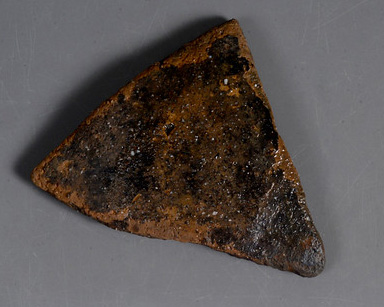 The UWF team has discovered ballast stones, iron concretions and articulated hull of the ship, including frames and hull planking, as well as remnants of ceramics once carried on it. They received a joint permit from the Florida Department of Environmental Protection and the U.S. Army Corps of Engineers to conduct test excavations through March 2017 to determine the extent of the shipwreck and the type of wood used to make the ship, which will indicate if it was among the earliest ships to be built in the New World.
The UWF team has discovered ballast stones, iron concretions and articulated hull of the ship, including frames and hull planking, as well as remnants of ceramics once carried on it. They received a joint permit from the Florida Department of Environmental Protection and the U.S. Army Corps of Engineers to conduct test excavations through March 2017 to determine the extent of the shipwreck and the type of wood used to make the ship, which will indicate if it was among the earliest ships to be built in the New World.
“We stand a good chance that this is a different type of ship from Emanuel Point I and Emanuel Point II,” said Dr. John Bratten, chair and associate professor of anthropology and co-principal investigator of Emanuel Point II. “Because it was found in shallower water than the others, it might be smaller, possibly what they called a barca. This discovery is significant in understanding 16th century ship construction.”
The UWF archaeology program’s exploration of the Luna fleet has been funded in part by a Special Category Grant totaling more than $290,000 from the Florida Division of Historical Resources. The matching grant, awarded to UWF in 2014, provided funding for faculty, staff and students from UWF to conduct fieldwork, laboratory analysis, artifact conservation and curation, archival research in Spain and public outreach in all seasons for two years.
“This is an extremely exciting and timely discovery following the recent investigations at the nearby terrestrial Luna site,” said Dr. Timothy Parsons, director of the Florida Division of Historical Resources. “I’m very pleased that the Division can support this work through our Special Category Grants Program.”
Maritime field investigations by UWF, including continuing survey and excavations, have mainly focused on the six ships that were lost during a hurricane that hit Pensacola Bay in September 1559. The Luna expedition included 1,500 soldiers, colonists, slaves and Aztec Indians who traveled in 11 ships from Veracruz, Mexico, to Pensacola to begin the Spanish colonization of the northern Gulf Coast. The hurricane hit Pensacola one month after they arrived, sinking many of their ships and devastating their food supplies. After two years, the remnants of the colony were rescued by Spanish ships and returned to Mexico.
The Luna settlement in Pensacola lasted from 1559 to 1561, which predates the Spanish settlement in St. Augustine, Florida, by six years, and the English settlement in Jamestown, Virginia, by 48 years.
“Finding the third ship is highly significant because it confirms we have the whole fleet in Pensacola Bay,” added Dr. John Worth, associate professor of anthropology and principal investigator of the Luna land settlement. “The historical documents say that two ships were loaded, ready to go back to Spain. As long as we had just two shipwrecks, it could mean that the rest of the fleet was somewhere else. Now we know we really do have the fleet, not just two ships that happened to be from the fleet.”
Emanuel Point I was found in 1992, and UWF archaeologists continued investigations through 1998 under the direction of Dr. Roger Smith, Florida State Underwater Archaeologist. In 2006, UWF archaeologists and students located Emanuel Point II. UWF continued to examine the second shipwreck with its summer field schools until grant funding was received in 2014. The funding has allowed UWF archaeologists to work continuously at the site and search for additional shipwrecks for two years.
The Luna land settlement was identified in October 2015 when Pensacola native Tom Garner discovered Spanish colonial and Native American artifacts at a privately owned residential lot within view of the two uncovered shipwrecks in Pensacola Bay. UWF has continued investigations at the settlement site since it discovery, including offering a land-based field school during Summer 2016. Together, the shipwrecks and land settlement provide a unique insight into the earliest multi-year European colonial settlement to be archaeologically identified in the United States.
“They found the third ship closer to land while we were working on a lower part of the settlement site,” said Dr. Elizabeth Benchley, director of the Division of Anthropology and Archaeology and the Archaeology Institute. “Watching the survey boat over Emanuel Point III, seeing how close it was to land and imagining this was where the people came and stepped ashore; it gives me goosebumps. It’s very powerful to put yourself in a location where you can envision what the landscape was like in 1559.”
Cantonment Neighborhood Cleanup Collects 23 Tons Of Debris
October 22, 2016
Escambia County collected and disposed of more than 23 tons (46,180 pounds) of debris during a recent Cantonment Neighborhood Cleanup, part of the county’s ongoing effort to help keep local neighborhoods and communities clean and safe. The event allowed residents to leave items at the curb to be disposed of free of charge by the county and partnering agencies.
The Cantonment Neighborhood Cleanup saw great participation from residents, with about 13,000 pounds of yard trash, 26,680 pounds of bulk waste, 3,900 pounds of tires and 2,600 pounds of household hazardous waste were placed at curbside for pickup, Escambia County officials said Friday.
The neighborhood cleanup initiative involves an aggressive clean-up effort, targeting different neighborhoods throughout the county, with crew members and volunteers picking up a variety of debris and waste, including electronics, furniture and household items. In 2015, more than 425 tons (851,220 pounds) of debris were collected and disposed of in Escambia County through the program. More than 500 tons (1,007,760 pounds) have been collected so far this year.
File photo.
Northview Battles To 12-10 Win Over 4A Walton
October 22, 2016
The 1A Northview Chiefs beat the 4A Walton Braves 12-10 during Senior Night at Tommy Weaver Memorial Stadium in Bratt.
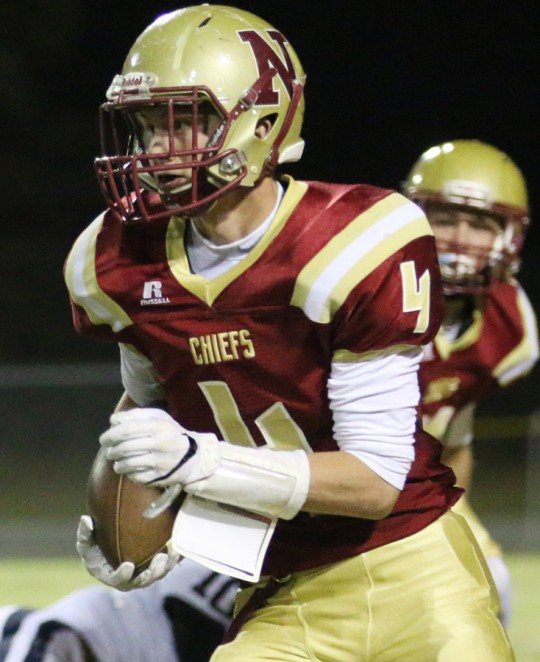 “It was a great game, two great football teams out here to battle tonight,” Northview Head Coach Derek Marshman said. “It was a battle in every sense of the word — two football teams that did not want to give up or give in. Both teams fought to the very end. It was everything that high school football is made of.”
“It was a great game, two great football teams out here to battle tonight,” Northview Head Coach Derek Marshman said. “It was a battle in every sense of the word — two football teams that did not want to give up or give in. Both teams fought to the very end. It was everything that high school football is made of.”
For a photo gallery, click here.
Northview took a 6-0 lead with 5:47 to go in the first quarter on a 60-yard quarterback keeper from senior Luke Ward. Walton added a touchdown and field goal to take a 10-6 lead with 9:39 remaining in the half.
Then with 8:56 remaining in the fourth quarter, Ward found Hunter Edwards for a 9-yard touchdown (pictured top) go ahead touchdown.
Several Chiefs stepped up on the way to win, Marshman said, including Micheal “MJ” Jones.
“MJ Jones played his tail off. He played a great football game on both sides of the ball. He played a great game defensively all night long…you put him on offense, he makes key blocks, key catches. Linebacker Ohijie Elliot made a great play to force a fumble and a sack to secure the game. Luke Ward played great. And a guy that’s really stepped out on top is senior running back Hunter Edwards…he’s going to run through guys, not run around guys,” he said.
Next week, the Chiefs (6-3, 1-0) will travel to Baker (8-0, 1-0) in a game that will decide the district championship. Both teams are in the 1A playoffs; the winner will have a home stadium advantage while the loser will hit the road in two weeks.
“We have a lot of momentum going into Baker. This was a big win for us tonight, to go undefeated at home and to win on senior night.,” Marshman said. “Next week is what is boils down to. But win, lose or draw, we going to go at it and go on.”
For a photo gallery, click here.
Look for cheerleader, band, ROTC, dance team and Senior Night photos by Monday on NorthEscambia.com.
NorthEscambia.com photos, click to enlarge.
Man Gets 15 Years On Child Porn Charges
October 22, 2016
A local man is headed to state prison on child pornography charges.
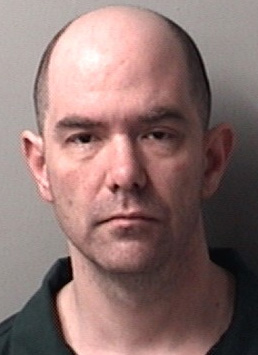 Andrew Allan Barlow was sentenced by Circuit Judge Jennie Kinsey to 15 years in state prison followed by 30 years of sexual offender probation and also designated as a sexual offender. Barlow entered a plea on August 26, 2016, to 10 counts of possession of certain images of child pornography.
Andrew Allan Barlow was sentenced by Circuit Judge Jennie Kinsey to 15 years in state prison followed by 30 years of sexual offender probation and also designated as a sexual offender. Barlow entered a plea on August 26, 2016, to 10 counts of possession of certain images of child pornography.
On January 15, 2016, the Florida Department of Law Enforcement received a tip from the National Center for Missing and Exploited Children regarding child pornography images being downloaded to a particular email address. Through investigation, it was determined the email address belonged to Brlow. Barlow was later interviewed and confessed to downloading and sharing images of child pornography. Additionally, a search warrant was conducteed on his electronic devices and revealed images and video of child pornography.
Tate Beats Choctaw 63-42
October 22, 2016
In a 105 total point game, Tate beat the Choctawhatchee Indians Friday night in Cantonment 63-42 for an Aggies Senior Night win.
Choctaw jumped out to a 7-0 lead at Pete Gindl Stadium just over a minute into the first quarter. A Jake Henry quarterback keeper touchdown run across midfield tied things up 7-7 at the 9:23 mark. Then Henry found Corey Moorer for an Aggie touchdown, Tate on Top 14-7 with 5:57 in the first.
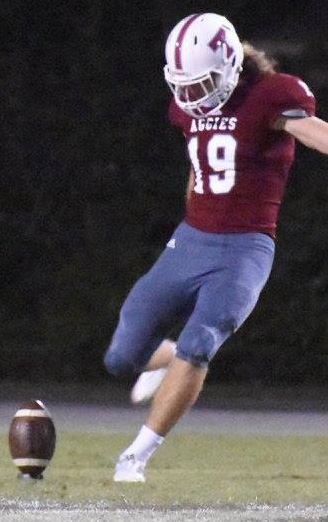 Choctaw then pulled ahead 21-14 with touchdowns late in the first and early in the second. Henry tied things up with a keeper and 67-year touchdown run at 7:35 in the second quarter, 21-21.
Choctaw then pulled ahead 21-14 with touchdowns late in the first and early in the second. Henry tied things up with a keeper and 67-year touchdown run at 7:35 in the second quarter, 21-21.
Tate went ahead 28-21 with 2:33 on the clock in the half when Henry found Ladarryl Page on a 6-yard touchdown pass. Tate expanded their lead to 34-21 when Henry completed a 3-yard pass to Rodriquez Smith for a touchdown with seven seconds in the half, 35-21 as the Showband of the South took to the field.
In the third, Henry was in again on a 70-yard run. With a good kick from Evan Legassey, Tate was up 42-21. The Aggies kept rolling with a 10 yard pass from Henry to Moorer for another TD, 48-21. After a Choctaw touchdown, Tate was up 56-28 on a 12-yard rushing touchdown from Paige with 2:21 to go in the third quarter.
The Indians scored touchdowns at the 10:23 and 3:22 marks in the fourth quarter.
The Aggies sealed the win with 3:22 to go in the game when Henry rushed five yards for a touchdown. Legassey’s kick was good for Friday night’s final, 63-42.
The Tate Aggies (7-2, 1-1) will travel to Pine Forest next Friday night for their final game of the regular season. A playoff spot is on the line in the game…both teams have lost this season for first place Escambia, so a win locks in the district runner-up spot.
Look for more game photos and photos from senior night by Monday on NorthEscambia.com.
NorthEscambia.com photos by Kristi Barbour, click to enlarge.
Bondi’s Office Looks For Clarity On Death Penalty
October 22, 2016
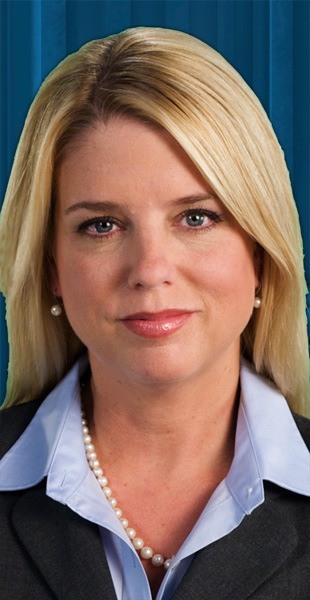 Attorney General Pam ondi has asked the Florida Supreme Court to clarify a ruling last week that struck down a portion of the state’s death-penalty law, arguing that failing to do so “will only generate confusion.”
Attorney General Pam ondi has asked the Florida Supreme Court to clarify a ruling last week that struck down a portion of the state’s death-penalty law, arguing that failing to do so “will only generate confusion.”
In a pair of opinions issued last Friday, the court found that a statute, passed in March in response to a U.S. Supreme Court decision in a case known as Hurst v. Florida, was unconstitutional “because it requires that only 10 jurors recommend death as opposed to the constitutionally required unanimous, 12-member jury.”
Bondi’s request for clarification came in the case of Larry Darnell Perry, who was convicted in the 2013 murder of his infant son. An appellate court had asked the Florida Supreme Court to decide whether the law passed in March applied to cases that were already under way.
In last Friday’s 5-2 decision in the Perry case, the court said that the law was unconstitutional because it did not require unanimous jury recommendations and “cannot be applied to pending prosecutions.”
The state contends that death penalty prosecutions can continue without a change in the law, so long as trial courts require unanimous jury recommendations to comply with last week’s ruling.
But the Supreme Court majority did not address the issue of “severability,” which would allow portions of the law that are not deficient to remain intact, Senior Assistant Attorney General Carol Dittmar wrote in the 11-page request filed Thursday.
“This omission unnecessarily invites continued litigation. The language leaves open the possibility that defense attorneys will assert that no valid death penalty law exists in Florida, demanding that trial judges strike notices of intent to pursue capital cases and refuse to impanel capital juries,” she wrote.
However, “the state maintains that after severing the constitutional defect, current capital prosecutions should still be conducted as long as the trial courts ensure that the jury’s final recommendation is unanimous,” Dittmar continued.
The arguments “will no doubt be rejected by some trial courts and accepted by others,” leading to more litigation in “an already overburdened system,” Dittmar wrote.
“…This court’s finding of a constitutional flaw will only generate confusion, absent some clarification as to trial court’s authority to cure the legislative error,” she argued.
But defense lawyers maintain that, a decade ago, the Supreme Court asked the Legislature to address the issue of unanimity. They say it’s now the Legislature’s job — not the court’s — to fix the law.
“It’s not clarification to ask the court to rewrite the statute,” said Martin McClain, who has represented over 200 defendants facing the death penalty.
Like Bondi, legislative leaders and prosecutors — who pushed for 10-2 jury recommendations in death-penalty cases over the repeated warnings of defense lawyers — contend that the statute does not have to be changed immediately for prosecutions to move forward.
But an Ocala judge on Monday put on hold the penalty portion of a murder trial, saying the court needed direction from the Legislature before proceeding.
Arguing for the state in the request for clarification, Dittmar wrote that the flaw in the statute “is easy to fix” through “accurate jury instructions and simple interrogatories” and “does not require any substantive rewriting of the law.”
But defense lawyers say that allowing trials to proceed without changing the statute could be even more problematic.
Relying on judges to craft jury instructions in different cases “is a situation that will cause havoc,” said 5th Judicial Circuit Public Defender Mike Graves, whose office represents Kelvin Lee Coleman in the Ocala murder trial and who argued Coleman’s case Monday. A jury late last week found Coleman guilty of two counts of first-degree murder.
“We literally could have dozens and dozens of different procedures, different jury instructions on the issue of death in individual cases. That, I think, would cause absolutely unnecessary complication in review,” Graves said. “I don’t for the life of me understand what their hurry is.”
The state’s death penalty has been in limbo since January, when the U.S. Supreme Court ruled that Florida’s sentencing system was unconstitutional because it gave too much power to judges, instead of juries. Following that decision, the Florida Supreme Court indefinitely put on hold two executions, which are still pending.
Of the 31 states with the death penalty, Florida is one of just three — including Alabama and Delaware — that have not required unanimous jury recommendations for death to be imposed. Delaware’s high court has halted that state’s death penalty following the U.S. Supreme Court’s decision in January in the Hurst case.
The Hurst ruling did not address the issue of unanimity, which became a flashpoint during this year’s legislative session as Florida lawmakers sought to repair the state’s death penalty sentencing process to comply with the U.S. Supreme Court decision.
Defense lawyers repeatedly told lawmakers that Florida’s “outlier” status regarding unanimity jeopardizes the state’s death penalty because the U.S. Supreme Court considers “evolving standards of decency” when considering the issue.
A Senate proposal originally required unanimous jury recommendations, but lawmakers ultimately struck a deal — backed by Bondi and prosecutors — in which at least 10 jurors were required to favor death for the sentence to be imposed.
“Refusing to make a steady, reasoned review of the situation is what led to the chaos our court system is now dealing with. Lives are literally at stake. Have patience. Take a breath,” Pete Mills, an assistant public defender in the 10th Judicial Circuit who is chairman of the Florida Public Defender Association’s death penalty steering committee, said in a telephone interview Friday.
“If the Court attempts to fix this on their own, it could be a violation of the separation of powers recognized in our state’s Constitution,” Mills said. “They run the risk of misinterpreting what the Legislature will do. The Legislature might have bigger plans.”
Incoming Senate President Joe Negron, a Stuart Republican who will take over as head of the chamber after the November elections, told The News Service of Florida this week that there was “no ambiguity” regarding the need for unanimous jury recommendations following the state Supreme Court opinions.
Negron, a lawyer, said that lawmakers could deal with the issue during next year’s 60-day legislative session, which begins in March.
Bernie McCabe, the state attorney in the 6th Judicial Circuit in Pasco and Pinellas counties, said he believes prosecutors can move forward because the state Supreme Court, in the decisions last week, “has established the procedures necessary if you’re going to seek the death penalty.”
But McCabe also said that the attorney general’s concern about clarification is valid.
“We have cases pending that need to be resolved, and there is perhaps confusion over the proper mechanism over how to resolve them,” he said.
McCabe said he is trying two cases in which he is seeking the death penalty that are at a critical stage.
“I think we can go ahead. Others will perhaps disagree,” he said. “I can see where it might be helpful if the Supreme Court just came out and said, OK, judges here’s what you do, and go ahead and do it.”
by Dara Kam, The News Service of Florida


